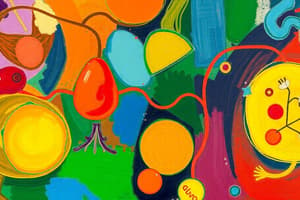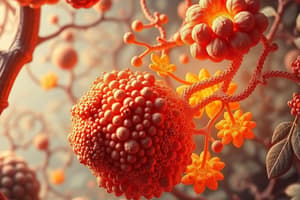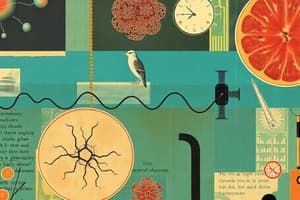Podcast
Questions and Answers
Which of the following is the primary role of gluconeogenesis in the liver?
Which of the following is the primary role of gluconeogenesis in the liver?
- Breaking down glucose to produce energy.
- Maintaining glucose homeostasis and ensuring availability for RBCs and the brain. (correct)
- Synthesizing glycogen for energy storage.
- Producing lactate for muscle contraction.
Why can't even-chain fatty acids result in net gluconeogenesis?
Why can't even-chain fatty acids result in net gluconeogenesis?
- They are directly converted into glucose in the liver.
- Acetyl-CoA, their breakdown product, can be used as a carbon source for glucose.
- They inhibit pyruvate carboxylase.
- Acetyl-CoA from even-chain fatty acids cannot serve as a carbon source for net glucose production because two carbons are lost as $CO_2$ in the TCA cycle. (correct)
Which of the following enzymes is unique to gluconeogenesis and bypasses an irreversible step in glycolysis?
Which of the following enzymes is unique to gluconeogenesis and bypasses an irreversible step in glycolysis?
- Pyruvate kinase
- Phosphofructokinase-1
- Glucokinase
- Glucose-6-phosphatase (correct)
During gluconeogenesis from lactate, which of the following occurs in the mitochondria?
During gluconeogenesis from lactate, which of the following occurs in the mitochondria?
In the Cori cycle, what is transported from the muscle to the liver?
In the Cori cycle, what is transported from the muscle to the liver?
Which of the following carbon sources can directly enter gluconeogenesis at the triose phosphate stage, thus requiring less ATP?
Which of the following carbon sources can directly enter gluconeogenesis at the triose phosphate stage, thus requiring less ATP?
How does fructose-2,6-bisphosphate regulate gluconeogenesis and glycolysis?
How does fructose-2,6-bisphosphate regulate gluconeogenesis and glycolysis?
What effect does increased hepatic Acetyl-CoA have on gluconeogenesis and pyruvate dehydrogenase (PDH)?
What effect does increased hepatic Acetyl-CoA have on gluconeogenesis and pyruvate dehydrogenase (PDH)?
Which hormone promotes the phosphorylation of the PFK-2/Fructose-2,6-bisphosphatase complex, decreasing fructose-2,6-bisphosphate levels?
Which hormone promotes the phosphorylation of the PFK-2/Fructose-2,6-bisphosphatase complex, decreasing fructose-2,6-bisphosphate levels?
Which of the following best describes the action of insulin on GLUT4?
Which of the following best describes the action of insulin on GLUT4?
In which tissues is GLUT2 primarily found, facilitating glucose uptake in an insulin-independent manner?
In which tissues is GLUT2 primarily found, facilitating glucose uptake in an insulin-independent manner?
What direct effect does glucagon signaling have on glycogenolysis and gluconeogenesis?
What direct effect does glucagon signaling have on glycogenolysis and gluconeogenesis?
How does epinephrine increase blood glucose levels during stress?
How does epinephrine increase blood glucose levels during stress?
During the absorptive (fed) state, which metabolic process is enhanced in the liver?
During the absorptive (fed) state, which metabolic process is enhanced in the liver?
What is the primary fate of fatty acids in adipose tissue during the absorptive state?
What is the primary fate of fatty acids in adipose tissue during the absorptive state?
Which process is favored in the liver during the post-absorptive state to maintain blood glucose levels?
Which process is favored in the liver during the post-absorptive state to maintain blood glucose levels?
During starvation, what becomes the major fuel source as glycogen stores are depleted?
During starvation, what becomes the major fuel source as glycogen stores are depleted?
What happens to citrate lyase activity in the absorptive state, and how does this affect fatty acid synthesis?
What happens to citrate lyase activity in the absorptive state, and how does this affect fatty acid synthesis?
What role does Malonyl-CoA play in the regulation of ketogenesis?
What role does Malonyl-CoA play in the regulation of ketogenesis?
Which of the following is true regarding the activity of lipoprotein lipase (LPL) in the absorptive state?
Which of the following is true regarding the activity of lipoprotein lipase (LPL) in the absorptive state?
Which of the following is a characteristic of Type A (infantile form) Pyruvate Carboxylase Deficiency?
Which of the following is a characteristic of Type A (infantile form) Pyruvate Carboxylase Deficiency?
Which set of conditions generally favor gluconeogenesis over glycolysis?
Which set of conditions generally favor gluconeogenesis over glycolysis?
Fatty acids can reduce translocation of this receptor to the cell surface
Fatty acids can reduce translocation of this receptor to the cell surface
Which of the following descriptions accurately reflects the activity of GLUT4?
Which of the following descriptions accurately reflects the activity of GLUT4?
Flashcards
What is Gluconeogenesis?
What is Gluconeogenesis?
Occurs in the liver to maintain glucose homeostasis and ensure glucose availability for RBCs and the brain.
What is Gluconeogenesis?
What is Gluconeogenesis?
A process that synthesizes glucose from non-carbohydrate precursors, such as lactate, amino acids, and glycerol, primarily in the liver. It is slower than glycolysis and maintains blood glucose during fasting.
What are unique Gluconeogenesis Enzymes?
What are unique Gluconeogenesis Enzymes?
Gluconeogenesis uses these to bypass the irreversible steps of glycolysis.
What is Gluconeogenesis from Lactate?
What is Gluconeogenesis from Lactate?
Signup and view all the flashcards
What is the Cori Cycle?
What is the Cori Cycle?
Signup and view all the flashcards
What are Gluconeogenic Amino Acids and Glycerol?
What are Gluconeogenic Amino Acids and Glycerol?
Signup and view all the flashcards
What is Regulation of Gluconeogenesis?
What is Regulation of Gluconeogenesis?
Signup and view all the flashcards
What produces Fru-2,6-bisphosphate?
What produces Fru-2,6-bisphosphate?
Signup and view all the flashcards
What is Pyruvate Carboxylase Deficiency?
What is Pyruvate Carboxylase Deficiency?
Signup and view all the flashcards
What is GLUT2?
What is GLUT2?
Signup and view all the flashcards
What is GLUT4?
What is GLUT4?
Signup and view all the flashcards
What is Preproinsulin?
What is Preproinsulin?
Signup and view all the flashcards
What is Glucagon Signaling?
What is Glucagon Signaling?
Signup and view all the flashcards
What is Epinephrine Signaling?
What is Epinephrine Signaling?
Signup and view all the flashcards
What happens to Glycolysis during the FED state?
What happens to Glycolysis during the FED state?
Signup and view all the flashcards
What happens to Glycogenolysis during the FASTING state?
What happens to Glycogenolysis during the FASTING state?
Signup and view all the flashcards
What happens during the STARVATION state?
What happens during the STARVATION state?
Signup and view all the flashcards
What occurs in a low glucagon:insulin ratio?
What occurs in a low glucagon:insulin ratio?
Signup and view all the flashcards
What occurs during a high glucagon:insulin ratio?
What occurs during a high glucagon:insulin ratio?
Signup and view all the flashcards
What molecules are increased during the absorptive state?
What molecules are increased during the absorptive state?
Signup and view all the flashcards
What occurs to fats in the fasting/starved state?
What occurs to fats in the fasting/starved state?
Signup and view all the flashcards
Study Notes
Glycolysis vs. Gluconeogenesis
- Glycolysis occurs in all cells to break down glucose for energy
- Gluconeogenesis occurs in the liver to maintain glucose homeostasis and ensure availability for red blood cells and the brain
- Regulation ensures glucose is broken down only when available, and glucose is built when stores are depleted
Overview of Gluconeogenesis
- Gluconeogenesis: De novo synthesis of glucose (reverse glycolysis)
- Process is slower than glycolysis
- Maintains blood glucose during fasting
- Occurs in the liver using precursors like lactate, amino acids, and glycerol
- There is no net gluconeogenesis from even-chain fatty acids but odd-chain and branched-chain can serve as minor precursors
- Even-chain fatty acids cannot serve as a carbon source for glucose because Acetyl-CoA cannot serve as a carbon source for glucose
- Oxidative decarboxylation of pyruvate into Acetyl-CoA is irreversible
- Two carbons are lost to CO2 during TCA cycle
Gluconeogenesis Enzymes
- Gluconeogenesis uses enzymes that overcome the irreversible stages of glycolysis
- Irreversible enzymes of glycolysis include:
- Glucokinase
- Phosphofructokinase-1
- Pyruvate kinase
- Gluconeogenesis enzymes include:
- Pyruvate carboxylase
- Phosphoenolpyruvate carboxylase
- Fructose-1,6-bisphosphatase
- Glucose-6-phosphatase
Gluconeogenesis from Lactate
- Involves both mitochondrial and cytosolic enzymes
- It is a relatively energy expensive process
- Lactate is converted back to glucose
- Lactate is converted to Pyruvate via Lactate Dehydrogenase (LDH)
- In mitochondrion, pyruvate is converted to oxaloacetate by pyruvate carboxylase (needs biotin and ATP)
- Oxaloacetate is reduced to malate via malate dehydrogenase
- Malate exits to cytosol and oxidized back to oxaloacetate by cytosolic malate dehydrogenase
- Oxaloacetate is decarboxylated to PEP via phosphoenolpyruvate carboxykinase (PEPCK) using GTP
Cori Cycle
- The Cori Cycle involves the lactate cycle in the liver, red blood cells, and muscle
Gluconeogenesis from Amino Acids and Glycerol
- Alanine and Glutamine are exported from muscle for gluconeogenesis
- They are the major source of carbon skeletons, but most other amino acids are also glucogenic
- These sources are converted into TCA cycle intermediates then to malate
- Alanine is converted to pyruvate via alanine aminotransferase
- Glycerol is the only component of fats that can be used for gluconeogenesis
- It enters at triose phosphates
- Steps include phosphorylation by glycerol kinase in liver
- Glycerol 3 phosphate dehydrogenase generates dihydroxyacetone phosphate (DHAP)
- Glycerol enters after pyruvate carboxylase (PC) and phosphoenolpyruvate carboxykinase (PEPCK) thus costing less ATP.
Regulation of Gluconeogenesis
- Primary regulation involves hormones
- Phosphorylation/dephosphorylation of enzymes are controlled by glucagon or insulin
- Primary control points are
- Phosphofructokinase-1
- Fructose-1,6-bisphosphase
- Fructose-2,6-bisphosphate is an allosteric effector that counter-regulates two opposing pathways and it activates PFK-1 and inhibits Fru-1,6-Bpase
Regulation of Gluconeogenesis with Fru-2,6-bisphosphate
- Fru-2,6-bisphosphate is produced by a bifunctional enzyme: PFK-2/Fru-2,6-Bpase
- It contains both kinase and phosphatase activity
- Glucagon leads to phosphorylation of fructose-2,6-bisphosphatase through protein kinase A
- Reduces Fru-2,6-BP decreasing stimulation of glycolysis at PFK-1
- Simultaneously reduces inhibition of gluconeogenesis, promoting a gluconeogenic mode in the liver
- Insulin mediates dephosphorylation thus activating PFK-2
- Increases Fru-2,6-BP activating PFK-1 and inhibits Fru-1,6-Bpase activity
- Triggers STORAGE rather than synthesis
- Gluconeogenesis is also regulated in mitochondria via Acetyl-CoA
- Increased hepatic Acetyl-CoA inhibits pyruvate dehydrogenase (PDH) and activates pyruvate carboxylase (PC)
Glucose Homeostasis
- Glucose homeostasis is maintained through hormonal regulation (Insulin and Glucagon)
Glucose Receptors
- GLUT2 involved in facilitated diffusion of glucose and fructose.
- GLUT2 Location: Liver, intestine, kidney, pancreatic β-cells, and brain
- Pancreatic islet β-cell uptake of glucose.
- High levels in the liver stimulate glycogenesis in an insulin-independent manner.
- In the fed state, responds to increased availability of glucose by increasing the rate of glucose uptake through the receptor
- Process stimulates insulin secretion.
- Intestine's function with it is to export glucose to plasma at the basolateral membrane.
- GLUT4 undertakes facilitated diffusion of glucose within skeletal and cardiac muscles, and adipose tissues
- It is insulin dependent
- Insulin signaling increases translocation of this receptor to the cell surface. Doubles the presence of the receptor.
- Muscle contraction increases this receptor expression, while fatty acids reduce translocation of this receptor to the cell surface.
Insulin and Insulin Signaling
- It is synthesized in the rough ER of pancreatic β-cells, and is transported via secretory vesicles from the Golgi
- Two polypeptide chains (alpha and beta) are joined by 2 disulfide bridges
- Preproinsulin is a single chain precursor that is cleaved into the signal peptide and proinsulin, and proinsulin is further split into C-peptide and insulin.
- Amino acid residues that bind the receptor are in blue boxes
Glucagon Signaling
- Stimulates glycogenolysis and gluconeogenesis
- Direct connection to the phosphorylation of the enzyme complex that regulates gluconeogenesis
- Triggers reductions in Fru-2,6-BP
Metabolic Effects of Insulin
- Promotes glucose uptake and glycogen synthesis in the liver and muscle
- Enhances glycolysis and lipogenesis in the liver
- Facilitates glucose uptake and triacylglycerol synthesis in adipose tissue
Metabolic Effects of Glucagon
- Inhibits glycolysis in the liver
- Stimulates glycogenolysis and gluconeogenesis in the liver
Glucagon and Liver
- Reaction cascade amplifies the hepatic response to glucagon
Epinephrine and Liver
- Activates glycogenolysis during stress to increase blood glucose
- Augments activities of glucagon on liver during severe hypoglycemia responses
- Phospholipase C
- Cleaves membrane phosphatidylinositol bisphosphate (PIP2) (phosphoprotein) leading to DAG and inositol trisphosphate (IP3, second messengers)
- Protein Kinase C
- Activated by DAG
- Serine-Threonine kinase
FED/Absorptive State
- Glycogen synthesis occurs in the liver and muscle
- Glycolysis is active in the liver and muscle
- Lipogenesis occurs in the liver
- Protein synthesis increases within muscle
Overnight Fasting State/Post-absorptive State
- Gluconeogenesis is active in the liver
- Lipolysis is increased in adipose tissue
Starvation State
- Gluconeogenesis is high in liver
- Ketogenesis is increased
- Lipolysis is high in adipose tissue
Regulation of Ketogenesis
- Ratio of Glucagon to Insulin determines fuel utilization and storage
- Insulin INHIBITS ketogenesis and stimulates acetyl CoA carboxylase
- High insulin occurs when glucose is converted to ATP and stored as Glycogen in Hepatocytes
- Fatty acids are converted to TAG and stored and synthesis of new molecules of fatty acids takes place for membranes and other needs
- Insulin levels decrease, and Glycogen stores are utilized for fuel
- Lipase activity increases and stored TAGs are released as Fatty Acids
- Fatty acids become major fuel source
- Malonyl-CoA is a regulator
Quick Summary
- Absorptive State
- Increased Citrate Lyase
- Increased Acetyl-CoA Carboxylase
- Increased Fatty Acid Synthase
- Active Lipoprotein Lipase in adipose capillary bed and inactive Lipoprotein Lipase at muscle unless exercise or activity is occurring
- Fasting/Starved State
- Decreased Elongation of fatty acids
- Utilization of fatty acids as a fuel source
Studying That Suits You
Use AI to generate personalized quizzes and flashcards to suit your learning preferences.




